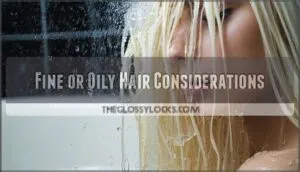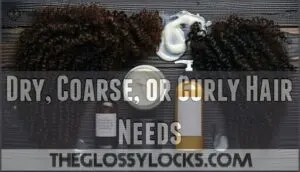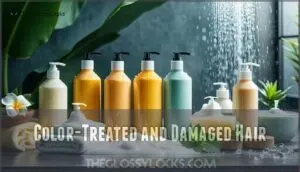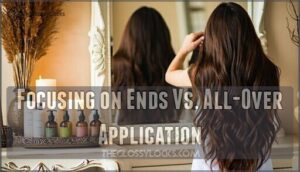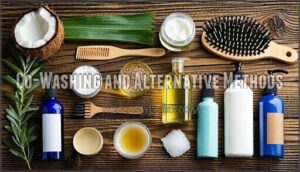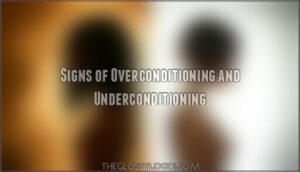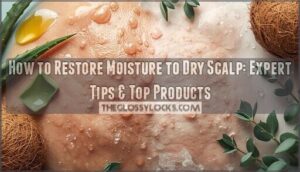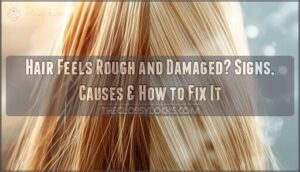This site is supported by our readers. We may earn a commission, at no cost to you, if you purchase through links.

Think of conditioner as your hair’s personal bodyguard—it shields strands from damage while locking in essential moisture and smoothing the cuticle for that enviable shine. Your hair type acts like a roadmap, guiding you toward the perfect conditioning frequency that prevents both the greasiness of over-conditioning and the brittleness of neglect.
Table Of Contents
- Key Takeaways
- What Does Conditioner Do for Hair?
- How Often Should You Condition Your Hair?
- How Hair Type Affects Conditioning Frequency
- Choosing The Right Conditioner for Your Hair
- How to Apply Conditioner Correctly
- How Often Should You Deep Condition?
- Signs of Overconditioning and Underconditioning
- Tips for Healthier, Stronger Hair
- Frequently Asked Questions (FAQs)
- What type of conditioner should I use?
- What is the difference between rinse-out, leave-in, and deep conditioners?
- How do I co-wash with conditioner?
- Can I condition my hair too often?
- Are there any benefits to applying conditioner to the roots of my hair?
- Can you condition wet vs dry hair?
- Should you condition before or after shampooing?
- How long should conditioner sit on hair?
- Can you use conditioner on your scalp?
- What happens if you skip conditioner entirely?
- Conclusion
Key Takeaways
- Your hair type determines conditioning frequency—fine or oily hair does best with 1-3 times weekly, while dry, curly, or color-treated hair needs daily moisture. – Conditioner acts as a protective shield, repairing damage, locking in moisture, and improving shine and manageability. – Overconditioning makes hair limp and greasy, while underconditioning leads to dryness, breakage, and persistent frizz. – Deep conditioning once a week is ideal for curly, damaged, or color-treated hair, but fine hair only needs it every 2-3 weeks.
What Does Conditioner Do for Hair?
Conditioner acts like a protective shield for your hair, depositing proteins and moisturizers that repair damage while restoring strength and flexibility.
Think of it as a daily vitamin for your strands—it smooths the hair cuticle, locks in moisture, and creates a barrier against breakage and environmental stress.
How Conditioner Restores Strength and Moisture
Think of conditioner as your hair’s personal bodyguard—it swoops in after shampooing to rebuild the protective barriers that cleansing strips away. Here’s how it works its magic:
- Protein Deposition fills microscopic gaps in damaged cuticles
- Moisture Balance restores hydration levels for hair health
- Cuticle Smoothing seals the hair shaft for shine and protection
- Elasticity Improvement prevents breakage during styling and brushing
- Damage Repair strengthens weakened strands from chemical processing or heat
Benefits for Hair Health and Appearance
When you use conditioner regularly, you’re basically giving your hair a protective shield that locks in moisture and smooths down the cuticles for healthier, shinier strands. This translates to reduced breakage, improved manageability, and enhanced shine that makes your hair look salon-fresh.
Regular hair conditioning frequency also boosts moisture retention while supporting frizz reduction, giving you that coveted smooth texture and natural volume.
Types of Conditioners and Their Functions
Not all conditioners work the same way, and picking the wrong type for your hair can leave you with lackluster results or even make things worse. Understanding formulation differences helps you match your hair type to the right product:
- Rinse-out conditioner provides basic moisture and detangling after shampooing
- Leave-in conditioner offers ongoing protection and hydration between washes
- Deep conditioner delivers intensive repair for damaged or severely dry hair
Each addresses different needs based on your hair’s condition.
How Often Should You Condition Your Hair?
How often you condition your hair really comes down to your hair type and what it needs. Fine or oily hair can usually skip a few treatments.
Dry, curly, or color-treated hair, however, often benefits from daily conditioning.
Most people benefit from conditioning every time they shampoo.
Frequency Recommendations by Hair Type
Your hair type determines how often you should reach for that conditioner bottle. Fine or oily hair thrives with conditioning just 1-3 times weekly—daily use can leave strands limp and greasy. Normal hair does well with conditioning 2-4 times per week, striking that sweet spot between moisture and manageability.
Curly hair and coily hair need more love, benefiting from conditioning after every wash since their texture makes it harder for natural oils to travel down the hair shaft.
Damaged hair from coloring or chemical treatments requires the most attention, with weekly deep conditioning helping restore strength and prevent further breakage. To maintain strong, shiny, and healthy hair, consider deep conditioning benefits.
Factors That Influence Conditioning Needs
Several key factors beyond hair type determine your conditioning frequency. Hair length plays a significant role—longer strands retain 40% less natural oil at the ends, requiring more frequent conditioning than shorter styles.
Environmental factors also impact your hair’s needs. Hard water increases dryness by 45%, while pollution exposure has boosted conditioning product demand by 61% since 2021.
Lifestyle habits matter too. Frequent exercisers condition up to four times more often due to sweat buildup.
Chemical treatments create the biggest impact. Bleached hair loses protective lipids 60% faster, and color-treated strands need 50% more conditioning to maintain structural integrity and prevent fade.
Recognizing signs of over or under-conditioning helps improve your hair care routine.
Common Myths About Conditioning Frequency
Somewhere along the way, conditioning became wrapped in more myths than a Hollywood celebrity’s skincare routine. Many believe daily conditioning causes buildup concerns or over-conditioning risks, but your hair type determines what works.
Others expect instant results from any conditioner, ignoring that effective hair conditioning techniques require consistency.
The biggest myth? One-size-fits-all approaches work for everyone’s hair care routine.
How Hair Type Affects Conditioning Frequency
Your hair type acts like a blueprint for how often you should condition, with fine or oily hair needing less frequent treatment while dry, coarse, or curly textures requiring more regular moisture.
Understanding whether your strands are naturally thirsty or prone to buildup helps you create a conditioning schedule that keeps your hair healthy without weighing it down.
Fine or Oily Hair Considerations
If your hair has a tendency to get greasy quickly or feels weighed down after washing, you’re likely dealing with fine or oily hair. This hair type needs a lighter approach regarding conditioning.
Focus rinse-out conditioner only on your ends, avoiding the scalp area where natural oils accumulate. Your hair type benefits from conditioning every other day or even less frequently. This approach maintains proper hair moisturizing without disrupting your scalp balance.
Dry, Coarse, or Curly Hair Needs
For dry, coarse, or curly hair, moisture balance is everything—your strands lose hydration faster than straight hair due to hair porosity and natural curl patterns. Deep conditioning at least once weekly helps lock in hair hydration, improve curl definition, and aid damage repair.
Here’s what your curly hair management routine should include:
- Condition after every wash (2–3 times weekly) to maintain hair moisturizing and frizz control
- Use leave-in conditioners with proteins to reduce breakage by up to 35%
- Co-wash 1–3 times weekly to cleanse without stripping essential moisture
- Increase deep conditioning frequency during dry seasons when water loss nearly doubles
Color-Treated and Damaged Hair
Color-treated hair shares more in common with curly hair than you might think—both need extra love because their structure has been compromised, making them thirsty for moisture and prone to breakage.
Condition daily or every other day to promote hair hydration and damage control. Deep conditioner once weekly helps with breakage prevention and hair restoration, while color repair formulas maintain toner maintenance.
This consistent hair care routine keeps chemically treated strands healthy and vibrant.
Choosing The Right Conditioner for Your Hair
Not all conditioners work the same way, and picking the right one makes all the difference in how your hair looks and feels.
Understanding the main types—rinse-out, leave-in, deep conditioning treatments, and cleansing conditioners—helps you match the product to your hair’s specific needs.
Rinse-Out Vs. Leave-in Conditioners
Once you understand your hair type, the next step is choosing between rinse-out and leave-in conditioners—two products that work differently but can both play a role in your routine.
Rinse-out conditioner smooths the hair cuticle after shampooing and gets washed out within minutes, making it ideal for regular hair moisture without product buildup.
Leave-in conditioner stays in until your next wash, offering longer-lasting hydration and protection—especially helpful for dry or porous hair that needs extra conditioning assistance between washes.
Deep Conditioning Treatments
Deep conditioning isn’t just a luxury treatment—it’s your hair’s rescue mission when everyday conditioner can’t quite cut it anymore. These intensive hair masks deliver deep repair through protein treatments and concentrated hair moisturizer that penetrate beyond the surface.
Think of deep conditioning as your hair restoration powerhouse—it addresses hair damage repair by flooding dry, stressed strands with nourishment for 20–30 minutes, giving your conditioning routines the boost they desperately need.
Cleansing Conditioners Explained
If you’ve ever wished you could skip a step in your hair care routine without sacrificing results, cleansing conditioners might just be the time-saver you didn’t know you needed.
These gentle formulas combine cleaning and conditioning benefits into one sulfate-free product, making them ideal for dry or curly hair types that don’t need traditional shampoo’s harsh cleansing.
They work by using mild surfactants that remove dirt without stripping natural oils, so your hair gets both repair and moisture in a single step.
How to Apply Conditioner Correctly
Knowing how to apply conditioner is just as important as choosing the right product for your hair.
The technique you use—whether you focus on the ends or coat every strand—can make the difference between healthy, manageable hair and a greasy, weighed-down mess.
Application Techniques for Different Hair Types
Knowing which conditioner to use is only half the battle—how you apply it makes all the difference in whether your hair looks healthy or weighed down.
For fine or oily hair types, concentrate conditioner application on the mid-lengths and ends only, avoiding roots to prevent greasiness. Coarse, curly, or textured hair benefits from all-over application methods, allowing the product to penetrate each strand fully.
When using leave-in conditioner or hair masks, adjust your application technique based on your hair texture—lighter formulas work best for finer strands, while thicker deep conditioners suit drier textures.
Focusing on Ends Vs. All-Over Application
Where you apply conditioner can make all the difference between hair that bounces with life and strands that fall flat by lunchtime. Your hair type and conditioner choice determine the best application methods:
- Fine or oily hair: Focus conditioner on the ends only, keeping it away from your scalp to prevent that greasy, weighed-down feeling.
- Dry, coarse, or curly hair: Apply all-over treatment from roots to tips since these textures crave moisture throughout.
- Medium-length hair: Concentrate on the bottom half where hair damage and repair needs are greatest.
Deep conditioner and leave-in conditioner work differently—one penetrates deeply during extended treatment, while the other protects throughout the day. Hair length impact matters too; longer strands need more end-focused conditioning techniques.
Co-Washing and Alternative Methods
Co-washing—short for conditioner-only washing—swaps out traditional shampoo for a cleansing conditioner, and it’s become a go-to method for people who want to clean their hair without stripping away natural oils. It works especially well for dry, coarse, or curly hair types that need extra moisture.
You can also try pre-shampoo treatments or hair masking before washing, or incorporate micro-exfoliating scalp scrubs to remove buildup. These alternative methods give you flexibility while matching your specific hair type and conditioning needs.
How Often Should You Deep Condition?
Deep conditioning is like giving your hair a spa day—it goes beyond regular conditioner to repair damage and restore moisture from the inside out.
How often you need it depends on your hair’s texture and condition, but most people benefit from a deep treatment once a week to once a month.
Deep Conditioning for Curly or Damaged Hair
Curly and damaged hair demands a different level of care—think of deep conditioning as the intensive repair session your strands have been craving.
For curly hair, aim for deep treatment masks once a week to maintain moisture balance and prevent hair breakage. Damaged hair often benefits from the same frequency, though severely compromised strands might need twice-weekly sessions.
These deep conditioning treatments work alongside your leave-in conditioner to lock in hydration and strengthen weakened areas.
Frequency Recommendations for Different Hair Textures
Your hair texture analysis plays a major role in determining how often to use deep conditioning treatments. Hair type classification and moisture balance go hand-in-hand when creating effective conditioning schedules.
Here’s what works for different textures:
- Fine or normal hair: Deep condition once every 2–3 weeks to maintain moisture balance without overloading strands that can become limp with excessive product selection.
- Coarse or thick hair: Weekly deep conditioning treatments help combat dryness and brittleness, with up to 40% reduction in breakage reported after consistent use.
- Curly or color-treated hair: Plan for weekly sessions as part of your hair care routine, since these textures lose moisture faster and benefit from regular hair damage prevention strategies.
Adjusting your hair washing frequency and conditioning treatments based on texture keeps your hair healthy without the guesswork.
Signs Your Hair Needs Deep Conditioning
Your hair will tell you when it’s thirsty—you just need to know how to listen to the signals. Excessive frizz, climbing dryness levels, or hair breakage with split ends appearing faster than usual are signs it’s time for deep conditioning.
Brittle strands, lack of shine, and tangles that won’t quit are clear indicators your hair type and texture need serious damage repair through proper hair moisturizing methods in your hair care routine.
Signs of Overconditioning and Underconditioning
Finding the right balance is key—your hair will tell you when something’s off.
Overconditioned hair feels limp, greasy, or weighed down, while underconditioned strands become dry, brittle, and prone to breakage.
Symptoms of Overconditioned Hair
When your hair feels unusually soft or almost gummy, you’re likely dealing with overconditioning. You’ll notice your strands lack volume and fall flat, even right after styling.
Your hair might appear greasy at the roots and struggle to hold curls or waves. Breakage increases as elasticity decreases, and you may experience scalp irritation from product buildup.
Frizz control becomes harder, and tangling worsens—all signs of moisture imbalance disrupting your hair’s natural strength and definition.
Recognizing Underconditioned, Dry Hair
While greasy, limp hair signals too much conditioning, the opposite problem—skipping conditioner too often—shows up in ways that are just as telling. Your hair sends clear distress signals when it’s underconditioned:
- Rough, straw-like texture that feels brittle and looks dull instead of smooth
- Increased breakage and split ends from compromised hair moisture and porosity issues
- Persistent frizz and tangles that no leave-in conditioner or hair moisturizer seems to tame
These dry hair causes point to one thing: your strands desperately need damage repair through consistent conditioning for breakage prevention.
Balancing Your Hair Care Routine
Finding the sweet spot between too much and too little conditioning might feel tricky at first, but it all comes down to paying attention to how your hair responds. Routine optimization means adjusting frequency as seasons change or your hair types and conditioning requirements shift.
Try product rotation—switching between lightweight and intensive formulas based on weekly needs. Incorporate scalp massage during application to boost hair nutrition, and remember that hair balance isn’t one-size-fits-all for effective hair maintenance.
Tips for Healthier, Stronger Hair
Keeping your hair healthy isn’t just about how often you condition—it’s about the whole picture.
Smart habits like preventing product buildup, using clarifying treatments when needed, and maintaining a clean scalp will strengthen your hair and help it look its best.
Preventing Buildup and Product Overuse
Too much of a good thing can backfire—when you pile on styling products, serums, and conditioners without removing buildup, your hair starts to feel heavy, look dull, and lose its natural bounce.
That’s where a minimalist hair routine comes in handy. Rotate your products based on your hair porosity and conditioning needs, and keep an eye on product ingredient analysis to avoid silicones and waxes that coat your strands over time.
Incorporating Clarifying Rinses
When buildup starts weighing down your hair despite cutting back on products, a clarifying rinse can reset your strands and remove the stubborn residue that regular shampoo leaves behind.
An apple cider vinegar rinse works beautifully as a DIY option—it restores your scalp health and preps your hair to absorb conditioner more effectively.
Use clarifying treatments once or twice monthly depending on your hair type and styling routine.
Maintaining Scalp Health and Hygiene
A healthy scalp is the foundation for beautiful hair, no matter how perfectly you’ve balanced your conditioning routine.
Your scalp microbiome thrives when you gently massage away product buildup during washing. Weekly exfoliation benefits both oily scalp and dry scalp conditions by removing dead cells that can clog follicles.
Regular scalp health and hygiene practices guarantee your hair type gets optimal benefit from your conditioner and overall hair care routine.
Frequently Asked Questions (FAQs)
What type of conditioner should I use?
Start by examining conditioner ingredients and product labels to match your hair texture needs. Rinse-out conditioner works for most hair types, while leave-in conditioner benefits dry or damaged strands.
Deep conditioning treatments restore severely compromised hair effectively.
What is the difference between rinse-out, leave-in, and deep conditioners?
Conditioner types break down into three main categories based on how long they stay on your hair.
Rinse-out conditioner gets applied after shampooing and washed out after 1-2 minutes, providing basic moisture balance and detangling.
Leave-in conditioner stays put until your next wash, offering ongoing hair repair and protection from environmental damage.
Deep conditioning treatments work their magic over 30+ minutes, delivering intensive moisture and product ingredients to restore seriously damaged or dry hair.
How do I co-wash with conditioner?
Co-washing uses conditioner to cleanse your hair without traditional shampoo, making it gentler on dry or textured strands.
- Wet hair thoroughly and apply cleansing conditioner from scalp to ends, massaging gently to remove buildup
- Rinse completely – leftover product can weigh down your hair and create unwanted residue
- Follow with leave-in conditioner on damp hair if your strands need extra moisture protection
Can I condition my hair too often?
Ironically, too much of a good thing can harm your hair—yes, you can over-condition. Excessive conditioning creates buildup that weighs hair down, causes limpness, and blocks natural oils from reaching your scalp.
| Hair Type | Max Frequency | Warning Signs |
|---|---|---|
| Fine/Oily | 2-3 times weekly | Greasy roots, flat appearance |
| Normal | Every other day | Heavy, lifeless strands |
| Dry/Curly | Daily (but monitor) | Mushy texture, no bounce |
| Damaged | 4-5 times weekly | Overly soft, stretchy hair |
Over conditioning disrupts your hair porosity balance. Hair becomes oversaturated with moisture and protein, losing its natural elasticity. This damage control issue requires adjusting your conditioning schedules based on your hair’s response.
Signs you’ve crossed conditioning limits include hair that feels gummy when wet, lacks volume, or appears dull despite treatment. Leave-in conditioner compounds this problem when combined with frequent rinse-out treatments.
Smart hair conditioning tips: Start with less frequent applications and gradually increase based on your hair’s needs. Your hair care routine should adapt to seasonal changes, styling habits, and chemical treatments. Effective hair damage prevention means knowing when to pull back on conditioning frequency.
The key lies in reading your hair’s signals rather than following rigid schedules.
Are there any benefits to applying conditioner to the roots of my hair?
Most hair types don’t benefit from root conditioning, but scalp health and hair follicle nourishment can improve with targeted techniques. Here’s when root conditioning helps:
- Dry scalp conditions – Light conditioner absorption at roots provides moisture without clogging follicles
- Fine hair needing volume – Leave-in conditioner applied sparingly to roots adds body
- Post-chemical treatments – Root nourishment helps repair damage from coloring or perming
- Protective styling – Hair conditioning tips suggest root application before braiding or extensions
- Weekly hair care routine – Incorporate scalp-focused hair moisturizer for overall health
Generally, focus conditioner on mid-lengths and ends where hair needs the most repair and hydration.
Can you condition wet vs dry hair?
Understanding hair porosity transforms your conditioning timing strategy. You can condition both wet and dry hair, but wet hair benefits from better product penetration.
Deep conditioning works best on damp strands, while leave-in conditioner applies effectively to towel-dried hair for maximum absorption.
Should you condition before or after shampooing?
Most hairstylists recommend conditioning after shampooing for ideal hair care results. The shampoo sequence matters because shampooing opens your hair cuticles, allowing the conditioner to penetrate better and deliver moisture where it’s needed most.
Here’s why product order affects your hair’s health:
- Shampoo first removes buildup – cleansing opens cuticles for better product absorption
- Conditioner seals and smooths – works best on freshly cleansed, slightly damp strands
- Hair porosity changes – shampooing increases porosity temporarily, improving conditioning effectiveness
- Leave-in conditioner comes last – applied to towel-dried hair for ongoing protection
- Conditioning methods vary – co-washing skips shampoo entirely for very dry or curly hair types
This traditional hair conditioning approach ensures your conditioner timing delivers peak benefits for stronger, healthier hair.
How long should conditioner sit on hair?
Regular conditioner needs just 2-3 minutes to work effectively, allowing time for moisturizing ingredients to penetrate your hair shaft.
Deep conditioning treatments require 15-30 minutes for optimal repair benefits, especially for damaged or highly porous hair needing intensive moisture restoration.
Can you use conditioner on your scalp?
Instead of rubbing conditioner right onto your scalp, focus on your hair itself. Most formulas meant for the scalp can actually clog follicles and mess with your scalp’s health.
Focus conditioner application on mid-lengths and ends for best hair conditioning tips and hair hygiene.
What happens if you skip conditioner entirely?
Without conditioner, your hair is more likely to suffer from moisture loss, dryness effects, and split ends.
You’ll notice frizz increase, less shine, and more hair breakage—especially if you skip leave-in conditioner or deep treatments.
Conclusion
Did you know that nearly 70% of people condition their hair less often than experts recommend? Understanding how often you should condition your hair can make a visible difference in strength, shine, and manageability.
By matching your conditioning routine to your hair type, you’ll avoid both dryness and excess oil. Consistent care, customized to your unique needs, acts as a safeguard—helping your hair look and feel its best every day.
- https://www.healthline.com/health/how-often-should-you-condition-your-hair
- https://cosmeticworld.ca/blogs/articles/how-often-should-you-condition-your-hair
- https://business.yougov.com/content/52808-us-hair-care-trends-2025-consumer-concerns-routines-and-market
- https://pmc.ncbi.nlm.nih.gov/articles/PMC8138261/
- https://gomjcapelli.com/benefits-of-conditioning-treatments/

